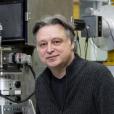
Showing 121 - 140 of 1063 results
Advanced Diffraction & Scattering Beamlines (ADS-1 and ADS-2) UNDER CONSTRUCTION
The Advanced Diffraction and Scattering beamlines (ADS-1 and ADS-2) are two independently operating, experimentally flexible beamlines that will use high-energy X-ray diffraction and imaging to characterise the structures of new materials and minerals.
FLEET appointment
Instrument scientist and expert in low dimensional magnetism Dr Kirrily Rule joins FLEET ARC Centre.
Australian scientists helping end malaria
An accurate and inexpensive test for Malaria just around the corner
Visit the Australian Synchrotron
ANSTO's Melbourne location is home to the ANSTO-owned and operated Australian Synchrotron. The Synchrotron is one of the Australia's most significant pieces of scientific infrastructure.

Bacteria-driven remediation of iron ore tailings
Billions of tonnes of iron ore tailings are generated each year from the mining industry. Converting these toxic tailings into soil-like materials which can develop and sustain plant and microbial communities is critical for mine site remediation and improved environmental outcomes.

Instrument Calibration
ANSTO offers reliable and traceable calibration services for radiation survey meters, contamination monitors and electronic personal dosimeters.
Reconstructing a history of palaeoclimate in south-eastern Australia
The role of trace elements as palaeoclimate proxies has been explored in ANSTO-led collaborative environmental research.
Mud and magnetism provides insights into materials and environment: AINSE young researchers
Accessing ANSTO’s Service Portal
ANSTO offers a broad range of programs and services to various industries and customers. Many of these services, including the Australian Nuclear Medicine Traceability program, are supported by online customer portals.
Potential good news for a warming world
Collaboration finds that old carbon reservoirs are unlikely to cause a massive greenhouse gas release in a warming world.
Sci-fi or sci-fact
Symposium on advanced therapy
Science and medical experts meet in Adelaide to discuss great potential of particle therapy in Australia

User Meeting 2022 - Prizes & Awards
You are invited to submit to the various awards from ANSTO, User Advisory Committee (UAC) and Australian Neutron Beam User Group (ANBUG).

User Meeting 2024 - Awards & Prizes
You are invited to submit to the various awards from ANSTO and the User Meeting 2024 organising committee.

Role at ANSTO

Role at ANSTO
Last meal reveals eating habits of Australian sauropod
International research led by Curtin University and supported by ANSTO, has identified and studied the first sauropod dinosaur gut contents found anywhere in the world. The stomach content was preserved with a reasonably complete skeleton of the Australian Cretaceous species Diamantinasaurus matildae found in Winton Queensland.